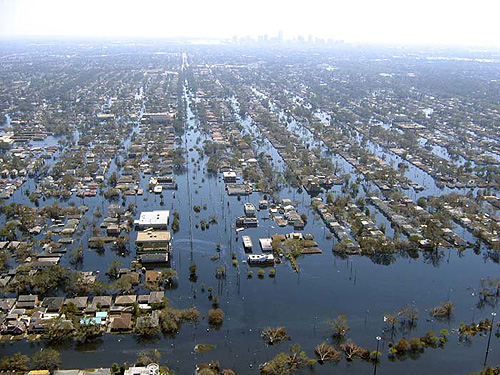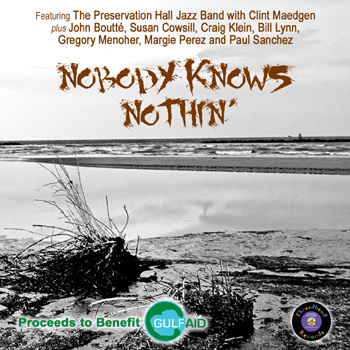Five years ago: 8/29/2005
Today we celebrate life in, and the continuing existence of, that incomparably wonderful place, the city of New Orleans.
Five years ago today, a fearsome hurricane on the Mississippi Gulf Coast but what should have been a run-of-the-mill hurricane of low-to-moderate strength in the city of New Orleans, came ashore. By the time the force of the hurricane reached the city the winds were only Category 2 and even down to a Category 1. There was some damage and lots of rain, but the city itself weathered the hurricane relatively well. The initial reaction was that “we dodged a bullet.”
Then the levee and floodwall system, designed and built by the U.S. Army Corps of Engineers, failed.

Here’s how it happened, demonstrated via an animated graphic from the Times-Picayune.
A very concise description of how fast things happened once the floodwalls and levees failed comes from the excellent Twitter feed of Crystal Kile, aka DJ Poptart at WTUL in New Orleans:
With all of the breaches, some neighborhoods flooded to the rooftops in minutes.
Even where the flooding was slower, further from the sites of the breaches, the water rose approximately 0.3 m (1 ft) every 10 minutes.
The lake level equalized with the floodwaters at midday on September 1, 2005. [That’s three days later.]
The failure of the levees and the flooding of New Orleans during Hurricane Katrina on August 29, 2005, represent the first time in American history that engineering failure has brought about the destruction or near-destruction of a major U.S. city.
There are five-years-later posts and articles all over the internets — there’s not a lot I can add. I wasn’t there until five weeks later, but I certainly had my own experiences with my family’s home. There are a couple hundred thousand other stories just like it (and, on the five-year anniversary, a hundred times more than that — that’s 20,000,000 — in Pakistan at the moment, which I simply cannot get my head around). Just look around and you’ll find plenty. But I do want to point you in a couple of directions.
First off, continuing to run on HBO this weekend is Spike Lee’s excellent documentary “If God Is Willing and Da Creek Don’t Rise”, a sequel to the one he did four years ago in the immediate aftermath of the Federal Flood, “When The Levees Broke: A Requiem in Four Acts.”
Then tomorrow is the one-night-only theatrical premiere of Harry Shearer’s long-awaited documentary film “The Big Uneasy,” which we will not miss.

Harry’s film will pull no punches, spelling out the reasons for the disaster (man-made, not natural as it was on the Mississippi Gulf coast), talking to New Orleans residents and whistle-blowers from the Corps of Engineers. As one prominent scientist said, had the floodwall and levee system worked as it was supposed to, the worst that Hurricane Katrina would have inflicted on New Orleans was “wet ankles.”
The odd tidbit of news about “The Big Uneasy” this weekend is that Harry, a longtime contributer to National Public Radio, submitted an ad to NPR for the film, which NPR subsequently rejected. The very brief ad stated that the movie was about “why New Orleans flooded.” According to NPR, “the language violated FCC guidelines.” However, they would allow the ad to say the movie was about “New Orleans and Hurricane Katrina.” Harry said, “The bickering went on for days.” I would like to see an explicit explanation of exactly how that language violated FCC guidelines.
Harry calls shenanigans on the explanation as well. “The FCC won’t let you say what your movie is about?” The NPR lawyers declined to offer any further explanation. Perhaps it’s because they’re Nice Polite Republicans?
“The Big Uneasy” plays in theatres tomorrow night only, August 30, in these theatres nationwide and at the following theatres in the Los Angeles area:
The Bridge 18, 6081 Center Dr, LA
The Grove 14, 189 The Grove Dr, LA
The Americana 18, 322 Americana Way, Glendale
The Culver Stadium 12, 9500 Culver Blvd, Culver City
Foothill Cinema 10, 854 E Alosta, Azusa
Agoura Hills 8, 29045 Agoura Hills Dr, Agoura Hills
Call for showtimes.
New Orleans has come a long way in five years, but still has a long way to go.









